- This essay is about the spiritual significance
of the Amarnath Yatra, its cultural history and sacred geography. It suggests
places to visit before the yatra. Lovely pictures make its reading more
worthwhile.
Amarnath …the ethereal existence of Shree Shiva in the lofty mountains of the Himalayas has been of great magnet for Shiva devotees to perform yearly yatra. In my study of sacred landscapes of Bharat, I was drawn to Amarnath Kshetra by its spiritual significance. As a conservation Architect and an expert in sacred geography, I had my own reasons to be interested. Sacred Geography is the study of qualities of the sacred and related cultural activities found in certain places and expressed in a spatial context. (Thorley, 2016)
However as I studied a variety of
resources associated with it studiously and persistently for three years,
realized that it had a deeper calling within me. I prepared my mind and heart
for this long journey as I wished to walk up following footsteps of Shiva
instead of a helicopter.
Amarnath Yatra: Popularity and
Significance
The long, arduous journey of Amarnath
Yatra through valleys, mountain tops and glaciers take your breath away, both
by its awe inspiring views and difficulty in taking breath.
It draws devotees from every corner of India.
For many devotees; especially from South India, it is leap of faith as they not
only have to cover great distance to reach; a sudden change in temperature to
chilling cold is hard to bear. Add to it a sudden change in elevation from near
to sea level to 14,000 feet; imagine the vagaries that human body has to
endure. The unshakable faith in Shiva also draws people from all age groups.
Much before the shrine board came up with an age limit, one would see children
walking with parents and grandparents.
In a country with many popular religious kshetra, it may seem one of them, but
Amarnath Yatra is very special and different from the rest owing to the peculiar
religious belief associated with it.
If we delve into the cultural history of
Amarnath Yatra, it reveals interesting information about its unique character. Bhrngisa Samhita, a manuscript compiling information about kshetras in Kashmir, illustrates
the unique aspect of Amarnath Kshetra.

As (he) made all Gods free from death, the
seers with ancient wisdom called him Amareshwar.
From eternity, we human beings have been
afraid of or wary of death. Not only in Bharatvarsha but this is a trait across
the world. The wariness of death made seekers strive for immortality. So search
for elixir of life was an eternal quest of human civilizations. Like most
things have origin and death, so did Gods. This is one place which promised to
take away the possibility of death (in a metaphorical sense off course) by
revealing the truth of eternal existence.
Amar meaning
eternal existence, free from death or decay was an important cultural value
associated with this kshetra. So for devotees the yatra becomes a quest, a journey which they have undertaken, to be able to grasp this eternal truth…one that will set a seeker free from the spell of decay and death. So Amarnath yatra has been popular from times immemorial, as its references can be found even in Mahabharata. Interestingly Mahabharata records its geological
features as well as cultural and ethnic information about communities
associated with the yatra route.
There are various stotras which refer to Amarnath ice lingam. They have reinforced
its importance in our culture-religious mindscape.
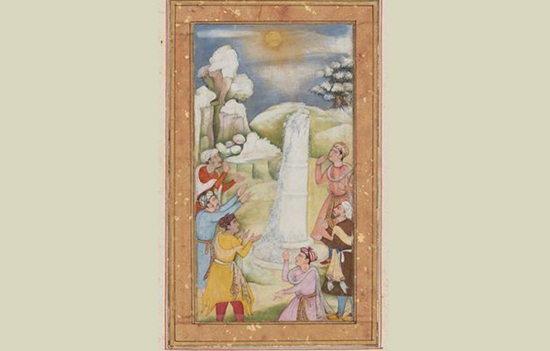 AKM154,
Mughal men admiring the miraculous ice lingam at Amarnath. Copyright Aga Khan
Museum.
AKM154,
Mughal men admiring the miraculous ice lingam at Amarnath. Copyright Aga Khan
Museum.
A separate Amarnath Mahatmya recording all prominent associated kshetras,
extolling virtues of undertaking pious deed in the kshetra is an important
historical resource which reveals its long continuity in Bharat.
Well known classics of Kashmir namely Nilmat Puran and Rajataragini, ancient treatises also refer to it. It had an awe-inspiring impact on the Indian civilization and travelers wrote about it in their travelogues. This forms an important part of historical evidence. Apart from devout Hindus, the royal Mughal officers of Akbar’s Court were mesmerized by it as recorded in Mughal paintings of that era.
Amarnath sacred Landscape: Ancient sites, early medieval Structures and Natural elements
The variety of landscape and its pristine beauty which is part of this yatra are unmatched and therein lies the essence of Amarnath.
Amarnath Kshetra is actually a cultural landscape consisting of natural geological elements with religious annunciation, historical structures development across centuries and local ethnic culture which had developed around it.
The ice formed Shiva lingam formation is
definitely important but as a final culminating point of kshetra. I wanted to visit and study all related sacred sites in terms of its ancient/Medieval associations as well as current practices.
Thus, my mind and heart being ready and
yearning, I decided to undertake the yatra and went through the mandatory health
checkups. That was no problem as I had earlier undertaken Adikailash and Om Parvat yatra, a 208 km walking trail through Greater Himalaya in Kumaon, Uttarakhand.
As I had studied Bhrngisa Samhita, Nilmat Puran and Rajataringini–sacred Granth along with later medieval historical resources, I wanted to follow the yatra in its full essence.
Yatra is much different from religious
tourism or off hand visits. For any yatra initiation into yatra is also
important. It is a simple act where we formally depart from our worldly
practices and begin the sacred journey. Previously I had undertaken Ayyapan Sabarimala
yatra, so I was aware of its purpose and the deep impact it can create on your
psyche and consequent spiritual experience. In simple words it helps your mind
shift gears, so that you are able to perceive the sacred presence in a much
open and sensitive manner.
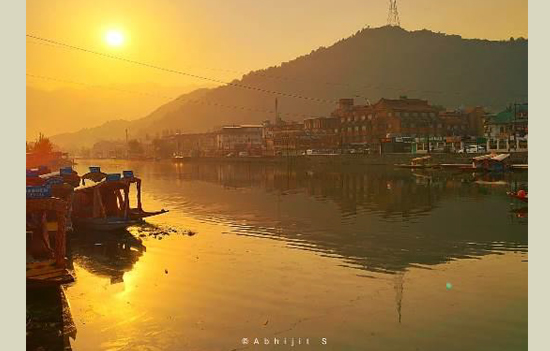 Shankaracharya Mandir, view from Dal Lake.
Shankaracharya Mandir, view from Dal Lake.
Initiation into Yatra
1. Shankaracharya Temple
Though there is no mandated initiation, I made an early morning visit to Shankaracharya temple to meditate and pray for darshan. It is located in the Zabarwan Range, on top of the Shankaracharya Hill, at a height of app 6,200 feet. Shankaracharya Mandir commands Srinagar by a 1,000 feet elevation. Though vehicular access makes it easier, it is advisable to walk up the hill for darshan.
The Shree Shankaracharya temple was
earlier known as Jyotheshwara temple. The structure can be dated to the 6th
century. According to Kalhana, in 371 BCE King Gopaditya constructed the temple
of Jyeshta Rudra on the top of a hill. (Sasisekhara Toshakhani, 2009)
The temple sits on high ground and is
solidly built, devoid of any floral decorations. One has to walk up the steep
flight of stairs and then further up on upa
peeth as well as adhistana to
reach the temple garbha. The temple is square in its external form and has a circular
garbhagriha with its majestic lingam
of Jyeshta Rudra, a form of Shiva.
 Jyeshta Rudra Linga.
Jyeshta Rudra Linga.
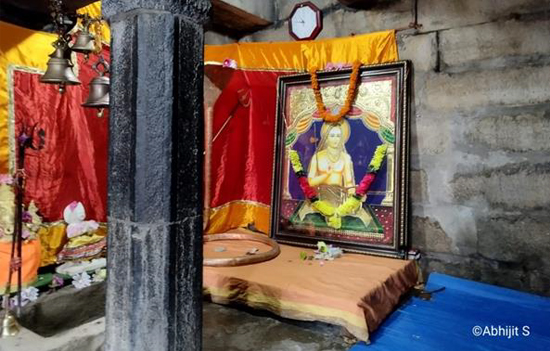 Tapasya sthal.
Tapasya sthal.
After performing puja, I circumbulated the
temple and visited another important sacred site i.e Tapasya sthal of Shree Shankaracharya. It is a small structure built over and around rocky outcrop. In the morning the place was quiet and once inside the temple I felt like I belonged to that place. I sat in padmasan in one dark corner and closed my eyes for dhyana. The place reverberates with meditative and tranquil qualities, making easier for any seeker to perform dhyana.
2. Sharika Bhavani
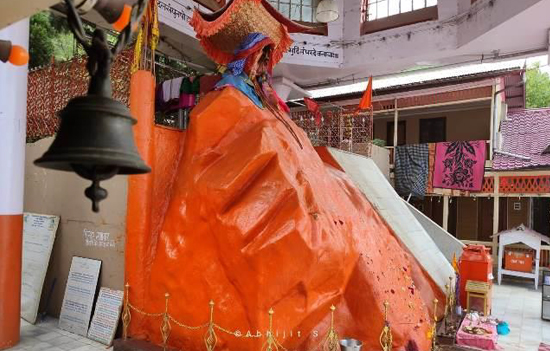 Sharika Bhavani.
Sharika Bhavani.
The second destination was Sharika Bhavani
located on Haari Parvat. Many mistake Hari for Vishnu but Haari means myna in
local dialect. As per religious history, Devi appeared in form of Myna to
vanquish the demonic forces and placed a pebble on demon which slowly grew in
size finally crushing him to death. The same rock is worshipped today as a manifestation
of Devi. It is called Sharika Peeth
Chakreshwar.
A pious pandit woman shared insights about
the place and the pastoral community who performed sacrifices there in past.
3. Meru vardhan Mandir
Located enroute to Pahalgam, this is one of the most spectacular temples I visited and is the best example of classic Kashmiri architecture. It is an ancient stone temple dedicated to Lord Shiva that lies within a square shaped tank to the north of Jhelum River.
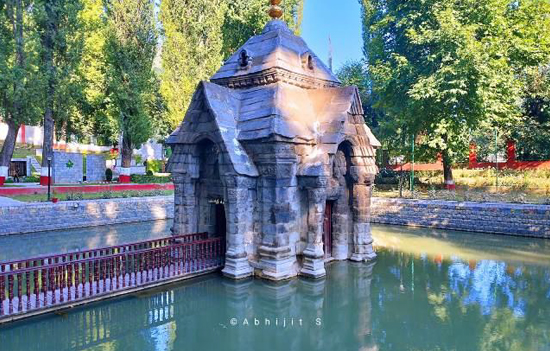 Meruvarshanswamy Temple.
Meruvarshanswamy Temple.
The temple was built by Meru, minister to
King Partha who ruled Kashmir from 921-931 AD and is situated in the center of
temple tank/pushkarni. The roof of the temple rises in a four way sloping form
with gables in each direction culminating into kalasha. It is chaturmukha
temple with doorways in all cardinal directions. A wooden bridge constructed
across provides access to the temple. The temple is inaccessible as it lies
inside the army camp. I was lucky to be with a person who helped me get access
and permission to click photographs.
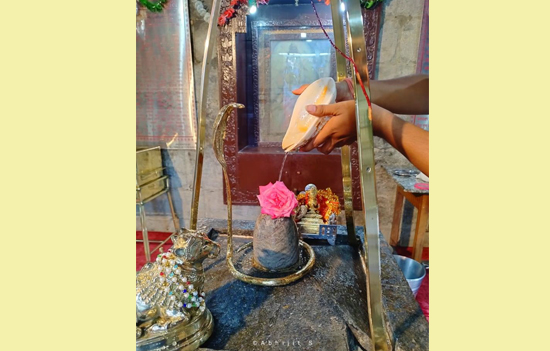 Performing Jalabhishek of Meru Swamy Lingam.
Performing Jalabhishek of Meru Swamy Lingam.
I happened to visit this shrine when a
religious group of Pandits from Tamil Nadu and Andhra Pradesh were performing rudra avartan (chanting of rudra). As
all officers and families sat in forecourt, temple was without a visitor. I
went in and sat in front of the Shivalinga for dhyana.
It was a tranquil experience sitting with
closed eyes and hearing rhythmic chanting of rudra in the background. The
chanting calmed my senses and I entered into dhyana easily. After a long time I
felt presence of someone so I opened my eyes. The priest had walked in. He offered
me a variety of conches to perform abhishek one by one. It was a very sublime
and mesmerizing experience. The peculiarity of the ritual and variety of
conches, as abhishekpatra with
elaborate metal work on some of them was very unique.
4. Avanti Swamy Temple Ruins
On the way, at Awantipora, a complex of twin temples called Avantiswami Temple are worth visiting. The complex contains temples of Shree Shiva and Shree Vishnu, exhibit co-existence of the Kashmir branch of Shaivism with local Vaishnava traditions .The entire site comprises of ruins of magnificent stone temples built by King Awantivarman during 853–855 CE.
5. Martand Sun Temple at
Mattan
I visited this temple prior to sunrise as I wanted to see impact of sun rise on this magnificent temple. When I reached it was quite dark. Surprisingly the gates were not locked so I walked in and sat in front of the entrance gateway. In the dark night, slowly the horizon became luminescent with golden light and from dark the tall and majestic profile of temple emerged against Usha Kiran
(the first rays of sun are referred to as usha kiran). I had visualized this
moment years before and was experiencing it. I walked inside chanting Aditya Hriday Stotra.

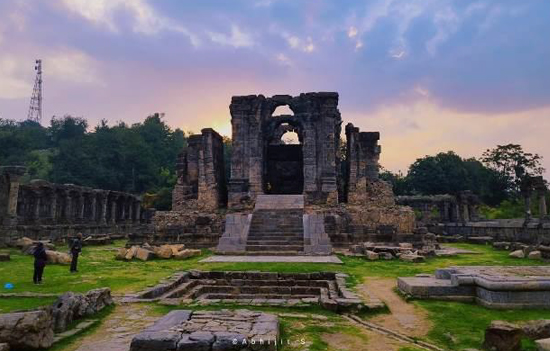 Martand Surya Mandir in early morning.
Martand Surya Mandir in early morning.
As I crossed into the temple court through its mammoth gate and observing the majestic profile of the temple in soft morning glow, a single ray filtered through a tree and fell through the roofless temple. For first time I experienced meaning of verses … He is pervading in all viz., Brahma (the creator), Visnu (the Sustainer), Shiva (the destroyer), Skanda (the son of Siva), Prajapati (progenitor of the human
race), the mighty Indra (lord of
senses), Kubera (the God of
prosperity), Kala (eternal time), Yama (the lord of death), Soma (the moon god that nourishes), and Varuna (God of rain)….
The Martand Mandir is majestic with its
massive doorways. I wondered how they enclosed them back then. Today most of the
complex is in ruins. However, the central shrine is partly restored. The
conservation works seems halfhearted but let us consider ourselves lucky that the
temple survived the religious pogrom.
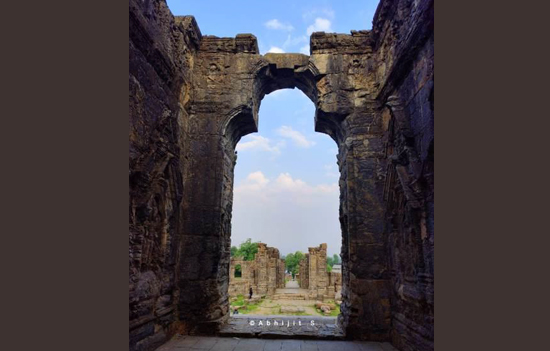 Massive doorways of Martand Surya Mandir complex.
Massive doorways of Martand Surya Mandir complex.
The central sun temple is west facing and its
shikhara destroyed. It sits on upapeeetha
which had numerous deities. Few idols have survived and provide a glimpse into
its past glory. Below niches of these shrines, sculptured panels illustrate
stories which depict contemporary life, customs associated with temple.
The temple complex contains a plinth of
subsidiary shrines possibly of consorts
of Shree Surya, It also has a square Jalakunda
with elaborate water channels chiseled in stone in front of the temple which
when full with water the reflection of the main temple would be sight to
behold.
I sat in front of the temple chanting
Gayatri mantra till sun rose in sky and I was touched by its rays. The temple premises
are enclosed by colonnaded passage which contained numerous shrines with their
multiple shikharas. The architecture and iconography of this temple is a
separate topic in itself.
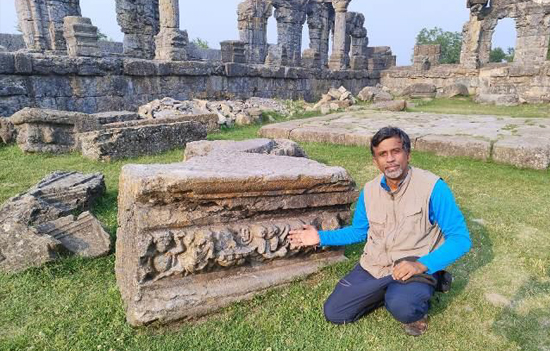 Author with ruins of motifs and sculptures.
Author with ruins of motifs and sculptures.
6. Pahalgam and Mamaleshwara Temple
Pahalgam is an important destination in the religious history of Amarnath. As per tradition when Parvati Devi requested Shivji to reveal the secret of immortality, both embarked on a journey to an appropriate place. At Pahalgam he left his vehicle Nandi behind and continued on foot. Hence, the name Bail-gao, over time, became Pahal-Gam. So this is place from where devotees start their journey on foot.
I wanted to spend some time at Lidder River,
once known as Lambodari, as there was a Ganesh murti along it. Today, after centuries of ethnic cleansing, few know about this except in the memoirs of Kashmiri Pandits. So I stayed at a resort which was located along the Lidder River and spent a day resting before the journey. I had my meals in the surging sound of the river and wish to thank the chef for Kashmiri cuisine which was simple yet ambrosial.
 Himalayan
White-browed Rosefinch Rajdeep Mitra.
https://macaulaylibrary.org/asset/132165121
Himalayan
White-browed Rosefinch Rajdeep Mitra.
https://macaulaylibrary.org/asset/132165121
As I sat under a Cherri tree reading Finding Shiva by Rukmini Vijaykumar, I
was occasionally visited by many birds of which, the Himalayan White-browed
Rosefinch I saw for first time.
The Mamaleshwar temple in Pahalgam is an important temple to visit before embarking on the yatra as there is specific mention of it in the Amarnath Mahatmya. According
to available data it a stone temple dated to 400 CE and located in the Lidder
river bed.
Yatra begins
The journey from Pahalgam is considered sacred as it traces footsteps of Shivji himself. Pilgrims are actually repeating the journey undertaken by Shree Shiva with Parvati Devi to reveal the essence of immortality.
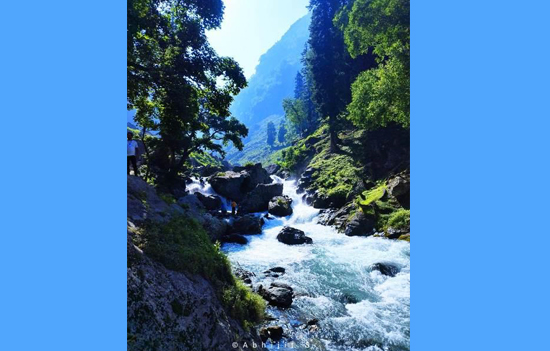 Picturesque rivulet at Chandnwari on Amarnath Yatra
Picturesque rivulet at Chandnwari on Amarnath Yatra
Chandanwari
I left Pahalgam at 5.00 am. A 25 km ride on a wavy road through picturesque landscape landed me at Chandanwari. After completing necessary formalities, I embarked on the yatra.
Chandanwari is an important site associated
with this journey of Shivji. As he embarked on the journey, he removed crescent
moon-chandra from his body and
released it at place which later came to known for it. (Chandra-n-wari)
Pissutop
This is the first geological feature to be
associated with religious value during the yatra. Pissutop is a steep climb
through rugged rock outcrops. The pleasant and idyllic landscape of Chandanwari
changes to much harsher and bare rock scape.
The rocky outcrops are associated with
fossils of demons who fought Gods, until the battle was ended by Shree Shiva.
Though the climb was hard, I was exhilarated as I realized I was becoming part
of legendary walk by Shree Shivji. At 11,500 feet Pissutop offers a splendid
view of Chandanwari valley which lies at 9,500 feet.
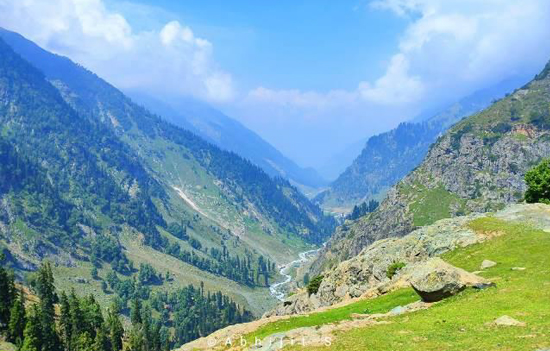 View from Pissutop.
View from Pissutop.
One of the best parts of walking alone in
a crowd is that you can maintain silence or continue chanting and experience
the landscape.
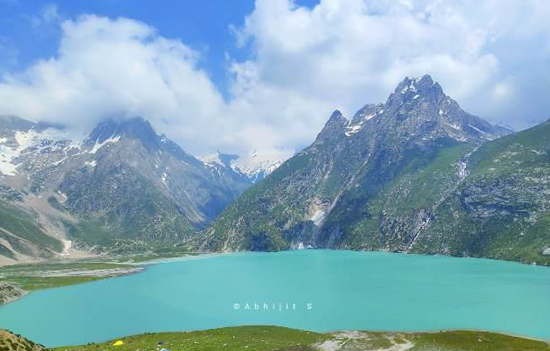 Sheshnag Lake.
Sheshnag Lake.
SheshNag (3590m)
Sheshnag Lake, one of the beautiful Oligotrophic lake with its unique ecosystem is an important halt in the yatra. Nestled in snowcapped mountains, the turquoise green water has a soothing effect on pilgrims.
Ganesh Top and Maha Gunas Top
I woke up at 4 am and was ready by 5 am. My
feet being stocked up in boots ready to go I was hoping to have a quiet 12 kms walk
till Panchtarini. But then realized a few hundred people were also at the gates
eager to begin yatra.
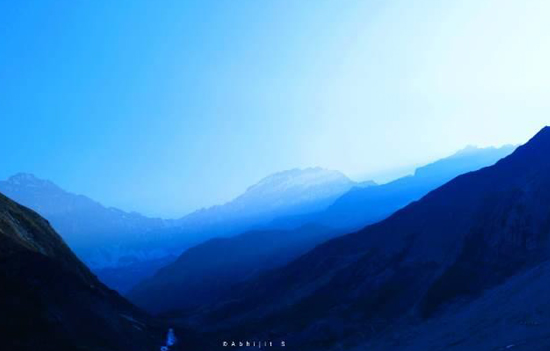 Mystical morning on Yatra.
Mystical morning on Yatra.
When we started, sunrays filtered through mountaintops lighting the horizon in mystical ways. By the time we climbed up, the glacial water of Ganesh Top was glistening with sunlight. Ganesh top is particularly important as it is an important source of water for the valley and contains numerous streams which are snow fed.
However after the Ganesh top climb crowds
thin out drastically if you are a fast walker.
Mahagunas Top at 14,700 feet marks a transition
point into another valley and an important pass of the region. As per tradition
Shivji and Parvati placed Ganesh in this region and descended in the Panchatarini
valley. This top is an important landmark in the yatra and has ecological
significance and distinguishing geological features.
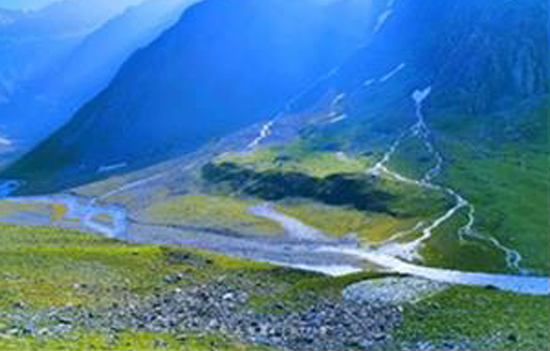 Water sources at Ganesh and Mahagunas Top.
Water sources at Ganesh and Mahagunas Top.
Panchtarini Valley
Panchtarni (Panchatarini), a low-lying valley land with many water courses is identified with confluence of five streams. The symbolism of pancha/ five is often associated with Panchamaha Bhuta
emanating from the cosmic dance of Shiva in the valley.
Sensing that he is close to his destination, Shivji performed tandava
and released panch tatvas
from his body thereby relinquishing control on working of universe, thereby
emptying self of all attachments. Next he retreated to Gufa (cave) in the mountain
to reveal the true knowledge of amaratva.
Pilgrims have to cross these five streams in wide riverbed to crossover to the Gufa
mountain which is allegorical of this spiritual stage in sadhana.
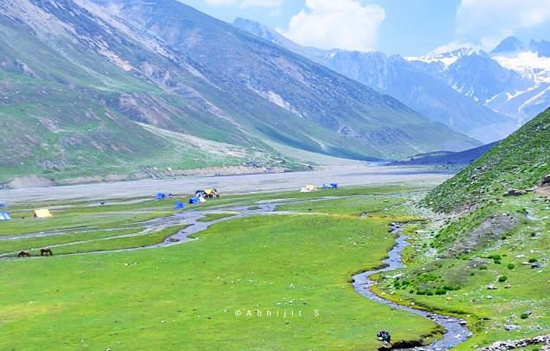 Panchtarini Valley.
Panchtarini Valley.
Gufa and Amarganga
A sheer climb leads to Amarnath Gufa (12,756 feet). A final culminating point of Shivji’s journey, a place he chose to reveal essence of immortality to Parvati Devi. The glacial water, as it permeates the mountain body and discharges into Gufa, turns into ice formation of a lingam. It is also the starting point of Amar Ganga which is one of six main tributaries of Sind river-Amarganga, Kolhol Ghar, Shitkadi Nala, Gund Nala, Surfraw Nala and Wangath Nala. Among other geological forms is Vasuki
Top which is a geological formation in the form of a serpent coiled around
mountain peak with hood.
After darshan I sat in one corner with
eyes closed. Soon I realized that I was sitting in a row of sadhus who were
being offered kheer. I promptly took kheer as I had walked on empty stomach for
darshan. It was one of the most fulfilling prasadam
I ever had.
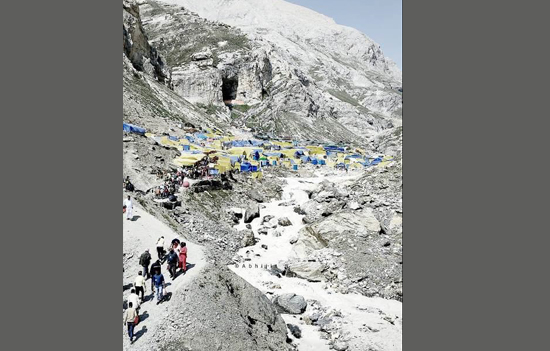 Gufa and Amar Ganga.
Gufa and Amar Ganga.
Return via Baltal Base
On the way back I took another route via Baltal. It was a straight climb down of 14 kms and saved me a couple of days as compared to the Pahalgam route. The route is tiring as one climbs down along Amarganga rivulet to Baltal (9, 000 feet). It is a beautiful road back to Srinagar via Sonmarg, winding along Sind River.
Though not mandated, I wanted to formally
end my yatra by visiting Jyeshta Rudra Temple (Shankaracharya Temple) to express
gratitude. It is a tranquil place to sit and reflect on precious moments of the
yatra.
Ucchishta…
Interestingly the journey of Shree Shiva
not only connects geological formations but also hydrological features Shivalingam-ice
formation, Amarganga-the melted glacier water stream, Panchatarini valley -
confluence of water stream and Sheshnag lake-Alpine lake.
The eco-cultural attributes of local communities particularly pastoral commonly associated with Amaranath are lost due to their adoption of Abrahamic faith. Unfortunately, the new faith does not recognize multitude of forces in nature. The other community of Pandits are displaced and struggling to maintain their livelihood, so the cultural aspect of immediate communities is lost to oblivion. However, the yatra has maintained its pan-Bharat cultural connections.
The Kolahoi Glacier with its Goddess of
light and Lambodari (associated with Ganesh) today called Lidder valley in
close vicinity of Amaranth are lost in terms of our understanding and knowledge
of their sacred landscapes.
The present Amarnath Yatra, which holds at its centre ‘essence of eternity’, has survived historical upheavals. The real challenge of Amarnath yatra is not about facilities and amenities, but to make it revealing in its true essence.
 Amarnath Yatra
Amarnath Yatra
References
The information is based on various
sources mentioned in Bibliography, interviews and on field observations as well
as experiences recorded by the author.
Author
Abhijit Sadhale is a conservation Architect who has specialized in Hindu Temples and sacred sites. As an expert in Hindu sacred landscapes he has explored spiritual, cultural Aspects and Natural Landscape with ecological significance in Amaranth Yatra.
Bibliography
1. Collection, P. (n.d.). Martnda
Mahatmya.
2. Dutt, J. C. (1986 Reprint). Rajataringini
of Jonaraja( translation). New Delhi: Gian Publishing House.
3. GADOO, C. L. (n.d.). Selected Writings
of C.L.Gadoo. Retrieved 2021, from Kashmir News Network: http://ikashmir.net
4. Sasisekhara Toshakhani, K. W. (2009).
Cultural Heritage of Kashmiri Pandits. Pentagon Press.
5. Thorley, A. (2016). Sacred Geography: A conceptual work in progress. SPICA-postgraduate journal of cosmology & culture, Vol: IV, no.2, 4.
6. V.D. N. Rao. (n.d.). Essence of
Amarnath Yatra Phala.
7. Warikoo, K. (april-June 1999).
Eco-Cultural Heritage of Kashmir. Himalayan & Central Asian Studies.
8. Kaul, A. (2019). Tradition of Sun worship in Kashmir. In D. Acharya, M. Slouber, and J. Törzsök (eds.) Proceedings of the 17th World Sanskrit Conference, Vancouver, Canada, July 9-13, 2018, Section 6: Tantra Studies. DOI: 10.14288/1.0391987.